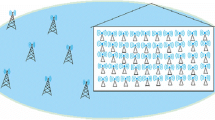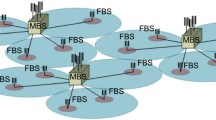Abstract
Femtocell deployment, which is a promising approach to the coverage and capacity improvement of indoor communications, suffers from cross-tier interference. Therefore to make the femtocell technology practical this issue needs to be addressed appropriately. One serious type of cross-tier interference occurs in downlink communication, in which a macrocell user is located far from its macro base station. In this setup, the communication of the adjacent femto access points with their users makes the macrocell user experience a low SINR. This paper considers this scenario and shows how cognitive-enabled femto access points can cope with cross-tier interference. More precisely, we compute the outage probability of macro users in a two-tier network when femto access points use the energy detection-based spectrum sensing technique to find the unoccupied frequency subband. To improve the outage probability of macro users, we also study the effectiveness of cooperation among neighbor femto access points. In all cases, the analytical expressions are validated by computer simulations which confirm the accuracy of the used approximations.







Similar content being viewed by others
References
Mahmoodi, T., & Seetharaman, S. (2014). Traffic jam: Handling the increasing volume of mobile data traffic. IEEE Vehicular Technology Magazine. doi:10.1109/MVT.2014.2333765.
Liu, J., Wu, J., Chen, J., Wang, P., & Zhang, J. (2012). Radio resource allocation in buildings with dense femtocell deployment. International Conference on Computer Communications and Networks (ICCCN). doi:10.1109/ICCCN.2012.6289286.
Damnjanovic, A., Montojo, J., Yongbin, W., et al. (2012). A survey on 3GPP heterogeneous networks. IEEE Transactions on Wireless Communications. doi:10.1109/MWC.2011.5876496.
Zhang, H., Jiang, C., Beaulieu, N. C., Chu, X., Wen, X., & Tao, M. (2014). Resource allocation in spectrum-sharing OFDMA femtocells with heterogeneous services. IEEE Transactions on Communications. doi:10.1109/TCOMM.2014.2328574.
Zahir, T., Arshad, K., Nakata, A., & Moessner, K. (2013). Interference management in femtocells. IEEE Communication Surveys and Tutorials. doi:10.1109/SURV.2012.020212.00101.
Wei, W., & Guanding, Y., et al. (2013). Cognitive radio enhanced interference coordination for femtocell networks. IEEE Magazine on Communication. doi:10.1109/MCOM.2013.6525593.
Banitalebi, B., & Zeinalpour-Yazdi, Z. (2015). On downlink performance of two-tier networks with time hopping modulation. IET Communications. doi:10.1049/iet-com.2014.0383.
Zeinalpour-Yazdi, Z., & Jalali, S. (2014). Outage analysis of uplink two-tier networks. IEEE Transactions on Communications. doi:10.1109/TCOMM.2014.2337871.
Chandrasekhar, V., Andrews, J., Muharemovict, T., Shen, Z., & Gatherer, A. (2009). power control in two-tier femtocell networks. IEEE Transactions on Wireless Communications. doi:10.1109/TWC.2009.081386.
Novlan, T. D., & Andrews, J. (2013). Analytical evaluation of uplink fractional frequency reuse. IEEE Transactions on Communications. doi:10.1109/TCOMM.2013.031213.120260.
Hasani-Baferani, M., Abouei, J., & Zeinalpour-Yazdi, Z. (2016). Interference alignment in overlay cognitive radio femtocell networks. IET Communications. doi:10.1049/iet-com.2015.0690.
Gharehshiran, O. N., Attar, A., & Krishnamurthy, V. (2012). Collaborative sub-channel allocation in cognitive LTE femto-cells: A cooperative game-theoretic approach. IEEE Transactions on Communications. doi:10.1109/TCOMM.2012.100312.110480.
Shafie-Kordshouli, M., Zeinalpour-Yazdi, Z., & Ramezanian, R. (2016). Coverage improvement in femtocell networks via efficient utility pricing. IET Communications. doi:10.1049/iet-com.2015.1047.
Zhang, H., Jiang, C., Beaulieu, N. C., Chu, X., Wang, X., & Quek, T. Q. S. (2015). Resource allocation for cognitive small cell networks: A cooperative bargaining game theoretic approach. IEEE Transactions on Wireless Communications. doi:10.1109/TWC.2015.2407355.
Adhikary, A., Ntranos, V., & Caire, G. (2011). Cognitive femtocells: Breaking the spatial reuse barrier of cellular systems. Information Theory and Applications (ITA). doi:10.1109/ITA.2011.5743563.
Chandrasekhar, V., & Andrews, J. (2009). Spectrum allocation in tiered cellular networks. IEEE Transactions on Communications. doi:10.1109/TCOMM.2009.10.080529.
Lien, S. Y., Lin, Y., & Chen, K. (2011). Cognitive and game-theoretical radio resource management for autonomous femtocells with QoS guarantees. IEEE Transactions on Wireless Communications. doi:10.1109/TWC.2011.060711.100737.
Attar, A., Krishnamurthy, V., & Gharehshiran, O. N. (2011). Interference management using cognitive base-stations for UMTS LTE. IEEE Communication Magazine. doi:10.1109/MCOM.2011.5978429.
Xie, R., Yu, F. R., Ji, H., & Li, Y. (2012). Energy-efficient resource allocation for heterogeneous cognitive radio networks with femtocells. IEEE Transactions on Wireless Communications. doi:10.1109/TWC.2012.092112.111510.
Cheng, S., Chon, A. W., Tseng, F., & Chen, K. (2012). Design and analysis of downlink spectrum sharing in two-tier cognitive femto networks. IEEE Transactions on Vehicular Technology. doi:10.1109/TVT.2012.2187692.
Lima, C. H. M., Bennis, M., & Latva-aho, M. (2012). Coordination mechanisms for self-organizing femtocells in two-tier coexistence scenarios. IEEE Transactions on Wireless Communications. doi:10.1109/TWC.2012.041912.110965.
ElSawy, H., & Hossain, E. (2012). On cognitive small cells in two-tier heterogeneous networks. In International Symposion on Modeling and Optimization in Mobile, Ad Hoc and Wireless Networks (WiOpt) (pp. 75–82).
Lima, C., Bennis, M., & Latva-aho, M. (2014). Two-tier hetnets with cognitive femtocells: Downlink performance modeling and analysis in a multi-channel environment. IEEE Transactions on Mobile Computing. doi:10.1109/TMC.2013.36.
Wang, W., & Zhang, Q. (2014). Local cooperation architecture for self-healing femtocell networks. IEEE Wireless Communications. doi:10.1109/MWC.2014.6812290.
Urgaonkar, R., & Neely, M. J. (2012). Opportunistic cooperation in cognitive femtocell networks. IEEE Journals on Selected Areas Communications. doi:10.1109/JSAC.2012.120410.
Heo, E., Park, H., & Jimaa, S. (2014). An efficient cooperation strategy and cooperation region analysis in cognitive femtocell networks. IEEE Vehicular Technology Conference (VTC). doi:10.1109/VTCFall.2014.6965867.
Li, Y., Zhang, H., & Asami, T. (2013). On the cooperation between cognitive radio users and femtocell networks for cooperative spectrum sensing and self-organization. IEEE Wireless Communications and Networking Conference (WCNC). doi:10.1109/WCNC.2013.6554605.
Jo, H. S., Sang, Y. J., Xia, P., & Andrews, J. (2012). Heterogeneous cellular networks with flexible cell association: A comprehensive downlink SINR analysis. IEEE Transactions on Wireless Communications. doi:10.1109/TWC.2012.081612.111361.
Zhang, H., Jiang, C., Mao, X., & Chen, H.-H. (2016). Interference-limit resource optimization in cognitive femtocells with fairness and imperfect spectrum sensing. IEEE Transactions on Vehicular Technology. doi:10.1109/TVT.2015.2405538.
Jiang, C., Zhang, H., Han, Z., Cheng, J., Ren, Y., & Hanzo, L. (2016). On the outage probability of information sharing in cognitive vehicular networks. IEEE International Conference on Communications (ICC). doi:10.1109/ICC.2016.7511436.
Zou, Y., Yao, Y.-D., & Zheng, B. (2011). Cognitive transmissions with multiple relays in cognitive radio networks. IEEE Transactions on Wireless Communications. doi:10.1109/TWC.2010.120610.100830.
Beaulieu, N. C. (2008). Fast convenient numerical computation of lognormal characteristic functions. IEEE Transactions on Communications. doi:10.1109/TCOMM.2008.060123.
Zeinalpour-Yazdi, Z., Nasiri-Kenari, M., & Aazhang, B. (2010). Bit error probability analysis of UWB communications with a relay node. IEEE Transactions on Wireless Communications. doi:10.1109/TWC.2010.02.090383.
Andrews, J., Baccelli, F., & Ganti, R. K. (2011). A tractable approach to coverage and rate in cellular networks. IEEE Transactions on Communications. doi:10.1109/TCOMM.2011.100411.100541.
Yucek, T., & Arslan, H. (2009). A survey of spectrum sensing algorithms for cognitive radio applications. IEEE Communication Surveys and Tutorials. doi:10.1109/SURV.2009.090109.
Zeinalpour-Yazdi, Z., & Jalali, S. (2013). On expected capacity of multicarrier frequency hopping systems. In Iran Workshop on Communication and Information Theory (IWCIT). doi:10.1109/IWCIT.2013.6555768.
Liang, Y.-C., Zeng, Y., Peh, E. C., & Hoang, A. T. (2008). Sensing-throughput tradeoff for cognitive radio networks. IEEE Transactions on Wireless Communications. doi:10.1109/TWC.2008.060869.
Lin, Y.-E., Liu, K.-H., & Hsieh, H.-Y. (2013). On using interference-aware spectrum sensing for dynamic spectrum access in cognitive radio networks. IEEE Transactions on Mobile Computing. doi:10.1109/TMC.2012.16.
Author information
Authors and Affiliations
Corresponding author
Appendices
Appendix 1: Derivation of missed detection probability at the FAP
A dual hypothesis testing that include \(H_0\) and \(H_1\) to represent absence and presence of the MU in a specific subband, respectively, is applied to our system model and defined as
where, \(y_r^f\) is the received signal at the FAP during the spectrum sensing process and existence of the MU is detected based on this parameter. The parameter \(b_M\) denotes the transmitted signal from MBS to the MU, \(h_{M,f}\) is the channel fading of the link between MBS and FAP and finally \(n_f\) refers to an AWGN with zero mean and variance \(\sigma _n^2\).
The energy detector which has been used by each FAP, firstly creates an output statistic, \(T\left[ {y_r^f} \right] \), using N samples of the received signal. Then the detector compares it with a certain threshold, \(\lambda \). Hence, the result of spectrum sensing at the FAP can be expressed as
For deterministic value of fading coefficients and path loss, according to the central limit theorem and also the results presented in [37, 38] \(H_0\) and \(H_1\) will be converged to the normal distribution for large N as
and
Now, \(P_{md}\) is easily obtained as
It is worthwhile to mention that the probability of false alarm (declaring that a subband is occupied while it is free) is equal to
Therefore in a desired specific value for the false alarm probability, the threshold level \((\lambda )\) in the energy detector can be computed as
Appendix 2: Average of missed detection probability at FC in the cooperative scheme
As mentioned previously, in the case of cooperation among neighboring FAPs the missed detection probability is equal to
where
Considering that channel coefficients \({h_{M,f}^{(i)}}\)s for \(i=1,\ldots N_{FAP}\) are independent from each other and follow Rayleigh distribution with parameter \(\sigma _{M,f}\) we can remove the effect of channel coefficient as
Applying GQR technique to the above integral resulting in
where \(\lambda \) is the threshold level of energy detector. Now from (34),
Finally as FAPs are distributed according to a PPP with density \(\lambda _f\) in a cooperation circle with radius \(R_c\), the average missed detection probability at FC is obtained as
where \(\kappa \) was defined in (37).
Rights and permissions
About this article
Cite this article
Zeinalpour-Yazdi, Z., Koleini, E. & Banitalebi, B. Outage performance of downlink communications in cognitive-based two-tier networks: cooperative and non-cooperative femtocells. Wireless Netw 24, 2645–2655 (2018). https://doi.org/10.1007/s11276-017-1492-3
Published:
Issue Date:
DOI: https://doi.org/10.1007/s11276-017-1492-3




